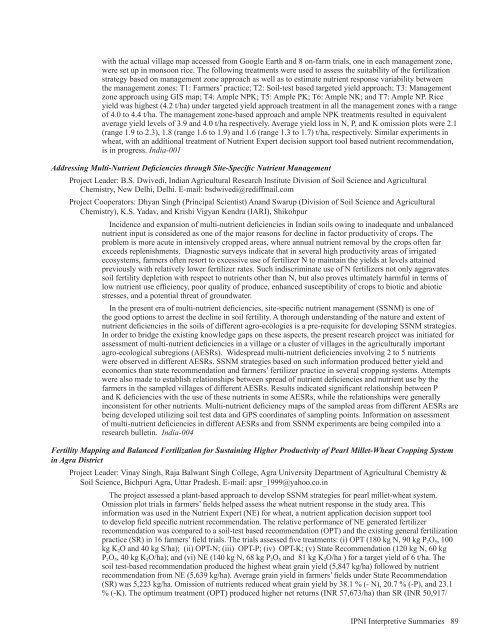Americas and Oceania Group - International Plant Nutrition Institute
Americas and Oceania Group - International Plant Nutrition Institute
Americas and Oceania Group - International Plant Nutrition Institute
Create successful ePaper yourself
Turn your PDF publications into a flip-book with our unique Google optimized e-Paper software.
with the actual village map accessed from Google Earth <strong>and</strong> 8 on-farm trials, one in each management zone,<br />
were set up in monsoon rice. The following treatments were used to assess the suitability of the fertilization<br />
strategy based on management zone approach as well as to estimate nutrient response variability between<br />
the management zones: T1: Farmers’ practice; T2: Soil-test based targeted yield approach; T3: Management<br />
zone approach using GIS map; T4: Ample NPK; T5: Ample PK; T6: Ample NK; <strong>and</strong> T7: Ample NP. Rice<br />
yield was highest (4.2 t/ha) under targeted yield approach treatment in all the management zones with a range<br />
of 4.0 to 4.4 t/ha. The management zone-based approach <strong>and</strong> ample NPK treatments resulted in equivalent<br />
average yield levels of 3.9 <strong>and</strong> 4.0 t/ha respectively. Average yield loss in N, P, <strong>and</strong> K omission plots were 2.1<br />
(range 1.9 to 2.3), 1.8 (range 1.6 to 1.9) <strong>and</strong> 1.6 (range 1.3 to 1.7) t/ha, respectively. Similar experiments in<br />
wheat, with an additional treatment of Nutrient Expert decision support tool based nutrient recommendation,<br />
is in progress. India-001<br />
Addressing Multi-Nutrient Deficiencies through Site-Specific Nutrient Management<br />
Project Leader: B.S. Dwivedi, Indian Agricultural Research <strong>Institute</strong> Division of Soil Science <strong>and</strong> Agricultural<br />
Chemistry, New Delhi, Delhi. E-mail: bsdwivedi@rediffmail.com<br />
Project Cooperators: Dhyan Singh (Principal Scientist) An<strong>and</strong> Swarup (Division of Soil Science <strong>and</strong> Agricultural<br />
Chemistry), K.S. Yadav, <strong>and</strong> Krishi Vigyan Kendra (IARI), Shikohpur<br />
Incidence <strong>and</strong> expansion of multi-nutrient deficiencies in Indian soils owing to inadequate <strong>and</strong> unbalanced<br />
nutrient input is considered as one of the major reasons for decline in factor productivity of crops. The<br />
problem is more acute in intensively cropped areas, where annual nutrient removal by the crops often far<br />
exceeds replenishments. Diagnostic surveys indicate that in several high productivity areas of irrigated<br />
ecosystems, farmers often resort to excessive use of fertilizer N to maintain the yields at levels attained<br />
previously with relatively lower fertilizer rates. Such indiscriminate use of N fertilizers not only aggravates<br />
soil fertility depletion with respect to nutrients other than N, but also proves ultimately harmful in terms of<br />
low nutrient use efficiency, poor quality of produce, enhanced susceptibility of crops to biotic <strong>and</strong> abiotic<br />
stresses, <strong>and</strong> a potential threat of groundwater.<br />
In the present era of multi-nutrient deficiencies, site-specific nutrient management (SSNM) is one of<br />
the good options to arrest the decline in soil fertility. A thorough underst<strong>and</strong>ing of the nature <strong>and</strong> extent of<br />
nutrient deficiencies in the soils of different agro-ecologies is a pre-requisite for developing SSNM strategies.<br />
In order to bridge the existing knowledge gaps on these aspects, the present research project was initiated for<br />
assessment of multi-nutrient deficiencies in a village or a cluster of villages in the agriculturally important<br />
agro-ecological subregions (AESRs). Widespread multi-nutrient deficiencies involving 2 to 5 nutrients<br />
were observed in different AESRs. SSNM strategies based on such information produced better yield <strong>and</strong><br />
economics than state recommendation <strong>and</strong> farmers’ fertilizer practice in several cropping systems. Attempts<br />
were also made to establish relationships between spread of nutrient deficiencies <strong>and</strong> nutrient use by the<br />
farmers in the sampled villages of different AESRs. Results indicated significant relationship between P<br />
<strong>and</strong> K deficiencies with the use of these nutrients in some AESRs, while the relationships were generally<br />
inconsistent for other nutrients. Multi-nutrient deficiency maps of the sampled areas from different AESRs are<br />
being developed utilizing soil test data <strong>and</strong> GPS coordinates of sampling points. Information on assessment<br />
of multi-nutrient deficiencies in different AESRs <strong>and</strong> from SSNM experiments are being compiled into a<br />
research bulletin. India-004<br />
Fertility Mapping <strong>and</strong> Balanced Fertilization for Sustaining Higher Productivity of Pearl Millet-Wheat Cropping System<br />
in Agra District<br />
Project Leader: Vinay Singh, Raja Balwant Singh College, Agra University Department of Agricultural Chemistry &<br />
Soil Science, Bichpuri Agra, Uttar Pradesh. E-mail: apsr_1999@yahoo.co.in<br />
The project assessed a plant-based approach to develop SSNM strategies for pearl millet-wheat system.<br />
Omission plot trials in farmers’ fields helped assess the wheat nutrient response in the study area. This<br />
information was used in the Nutrient Expert (NE) for wheat, a nutrient application decision support tool<br />
to develop field specific nutrient recommendation. The relative performance of NE generated fertilizer<br />
recommendation was compared to a soil-test based recommendation (OPT) <strong>and</strong> the existing general fertilization<br />
practice (SR) in 16 farmers’ field trials. The trials assessed five treatments: (i) OPT (180 kg N, 90 kg P 2 O 5 , 100<br />
kg K 2 O <strong>and</strong> 40 kg S/ha); (ii) OPT-N; (iii) OPT-P; (iv) OPT-K; (v) State Recommendation (120 kg N, 60 kg<br />
P 2 O 5 , 40 kg K 2 O/ha); <strong>and</strong> (vi) NE (140 kg N, 68 kg P 2 O 5 <strong>and</strong> 81 kg K 2 O/ha ) for a target yield of 6 t/ha. The<br />
soil test-based recommendation produced the highest wheat grain yield (5,847 kg/ha) followed by nutrient<br />
recommendation from NE (5,639 kg/ha). Average grain yield in farmers’ fields under State Recommendation<br />
(SR) was 5,223 kg/ha. Omission of nutrients reduced wheat grain yield by 38.1 % (- N), 20.7 % (-P), <strong>and</strong> 23.1<br />
% (-K). The optimum treatment (OPT) produced higher net returns (INR 57,673/ha) than SR (INR 50,917/<br />
IPNI Interpretive Summaries 89

















